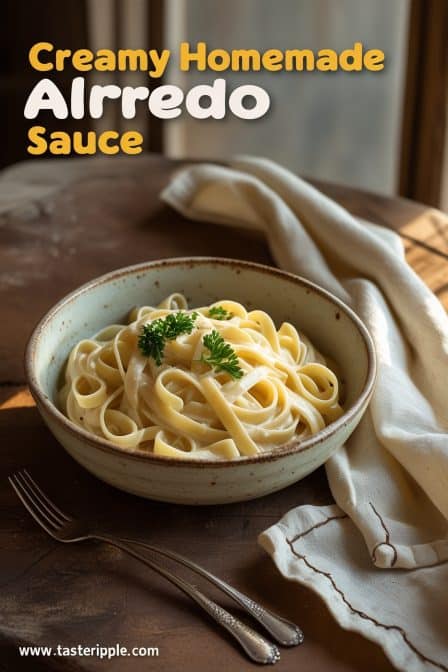There’s just something magical about Alfredo sauce, isn’t there? That luscious, velvety creaminess that clings perfectly to every strand of pasta—pure comfort in a bowl. If you’ve ever thought making Alfredo sauce from scratch is complicated or time-consuming, think again. This recipe whips up a rich, dreamy Alfredo sauce in just 10 minutes, using simple ingredients you probably have on hand.
This homemade Alfredo isn’t your run-of-the-mill jarred sauce. It’s bursting with fresh flavor, silky texture, and the perfect balance of cheesy and buttery goodness. Whether you’re craving a cozy dinner or impressing guests, this sauce will elevate any pasta, veggie, or protein with effortless elegance.
Let’s dive in and uncover what makes this Alfredo sauce so special, how to nail it perfectly every time, plus expert tips and tasty twists for customizing it to your liking.
Why This Alfredo Sauce Stands Out
- Quick & Easy: No fancy equipment or long simmering—just 10 minutes from start to finish.
- Rich & Creamy: Uses real cream and fresh Parmesan for that authentic indulgence.
- Balanced Flavor: Garlic and butter add depth without overpowering the cheese.
- Versatile: Perfect for fettuccine, chicken, shrimp, broccoli—you name it.
- No Thickening Agents: No flour or cornstarch needed, so it stays silky, not gluey.
Ingredients & Substitutions
| Ingredient | Amount | Notes & Substitutions |
|---|---|---|
| Unsalted butter | 4 tbsp (½ stick) | Use salted butter, reduce added salt accordingly |
| Garlic cloves | 2, minced | Garlic powder (½ tsp) in a pinch |
| Heavy cream | 1 cup | Half-and-half (for lighter sauce), but less rich |
| Freshly grated Parmesan cheese | 1 cup | Use Romano or Asiago for different flavor profiles |
| Salt | ½ tsp | Adjust to taste |
| Freshly ground black pepper | ¼ tsp | Add more for a peppery kick |
| Nutmeg (optional) | A pinch | Adds warmth; optional |
| Fresh parsley (optional) | For garnish | Adds freshness and color |
Step-by-Step Instructions
1. Melt the Butter & Sauté Garlic
In a medium saucepan over medium heat, melt the butter. Once melted, add the minced garlic and sauté for about 1 minute until fragrant—but be careful not to burn it! Burnt garlic turns bitter and ruins the sauce.
Pro tip: Use fresh garlic for the best aroma and flavor. Mince it finely so it disperses well.
2. Add the Cream
Pour in the heavy cream and stir to combine with the butter and garlic. Bring the mixture to a gentle simmer—not a boil—while stirring frequently.
3. Incorporate the Cheese
Lower the heat to medium-low. Gradually add the freshly grated Parmesan cheese, stirring constantly until it melts completely and the sauce thickens slightly. Don’t rush this step—slowly melting the cheese ensures a silky texture without clumps.
4. Season the Sauce
Add salt, freshly ground black pepper, and a pinch of nutmeg if using. Taste and adjust seasoning. Keep in mind Parmesan is salty, so add salt carefully.
5. Serve Immediately
The sauce thickens as it cools, so toss it with your cooked pasta or desired dish right away. If needed, thin the sauce with a splash of pasta cooking water for perfect coating.
Cooking Techniques & Science Behind the Sauce
Alfredo sauce is essentially an emulsion of butter, cream, and cheese. The butter and cream provide fat, which helps melt the cheese smoothly, creating that signature creamy texture. Parmesan cheese melts differently than mozzarella or cheddar—it’s dry and granular, so it must be added slowly and gently stirred to avoid clumping.
The key is controlling heat—too high, and the cheese separates or becomes grainy. Medium-low heat lets the cheese melt evenly. The little pinch of nutmeg brightens the flavor subtly, complementing the richness.
Tips & Variations
- For lighter sauce: Swap heavy cream for half-and-half or whole milk but expect a thinner sauce.
- Make it garlicky: Add extra garlic or roast it for a mellow flavor.
- Add protein: Stir in cooked grilled chicken, shrimp, or sautéed mushrooms for a complete meal.
- Herbs: Fresh basil, thyme, or parsley work beautifully for garnish or stirred in.
- Spicy Alfredo: A dash of crushed red pepper flakes adds a surprising kick.
- Dairy-free: Use coconut cream and nutritional yeast, but flavor will differ from classic Alfredo.
Storage & Reheating
Alfredo sauce is best fresh but can be refrigerated in an airtight container for up to 3 days. When reheating, warm gently on the stove over low heat, adding a splash of cream or milk to loosen it up. Avoid microwaving on high heat as it may cause separation.
Serving & Pairing Suggestions
- Toss the sauce with fettuccine or linguine for classic Fettuccine Alfredo.
- Drizzle over steamed broccoli or roasted vegetables for a decadent side.
- Use as a creamy base for baked chicken Alfredo casseroles.
- Pair with a crisp green salad and a glass of chilled Chardonnay or Pinot Grigio.
Best Time to Serve
This Alfredo sauce shines as a comforting weeknight dinner or special occasion treat. It’s perfect for chilly evenings when you crave something rich and satisfying without hours of prep.
Final Thoughts
Making your own Alfredo sauce is surprisingly quick and incredibly rewarding. Once you master this simple recipe, you’ll never go back to jarred versions. The freshness, richness, and silky texture are unbeatable. Keep your ingredients quality, control the heat, and adjust seasoning to your taste. With these tips, you’re just 10 minutes away from creamy, dreamy pasta perfection.
FAQs
Q: Can I make Alfredo sauce ahead of time?
A: Yes, but it’s best served fresh. If making ahead, reheat gently with a splash of cream to restore creaminess.
Q: What’s the difference between Alfredo sauce and white sauce (béchamel)?
A: Alfredo sauce uses cream, butter, and Parmesan without flour, while béchamel is a roux-based white sauce made with butter, flour, and milk.
Q: Can I use pre-grated Parmesan?
A: Freshly grated is best for smooth melting. Pre-grated often contains anti-caking agents that can cause graininess.
Q: How can I thicken a thin Alfredo sauce?
A: Simmer gently to reduce it, or add more cheese slowly. Avoid high heat to prevent separation.
Q: Is Alfredo sauce gluten-free?
A: Yes, this recipe contains no flour or gluten ingredients—safe for gluten-free diets.
Ready to impress with your own creamy Alfredo? Grab your butter and Parmesan, and let’s get cooking!

